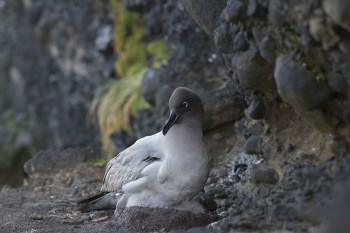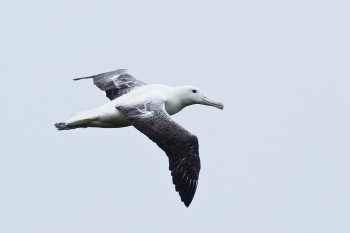The Auckland Islands lie some 465 km south of New Zealand’s South Island, and comprise the largest island group in the New Zealand sub-Antarctic. The archipelago consists of four large islands (Auckland, Enderby, Adams and Disappointment), together with a set of smaller islands. The group is a National Nature Reserve and forms part of the New Zealand Sub-Antarctic Islands World Heritage Site that was inscribed in 1998. The island group is surrounded by a recently declared large marine reserve: the Auckland Islands/Motu Maha Marine Reserve that covers an area of c. 484 000 ha (click here).

Looking towards Enderby Island from the main island of Auckland with smaller Rose Island in between
Enderby Island is a 710-ha low-lying island with a maximum elevation of 45 m located at the northern end of the Auckland Islands archipelago. Southern Rata Metrosideros umbellata forms thick forests and scrub along the south and east side of the island, but elsewhere the vegetation changes to moorland that covers a broad belt in the centre of the island, with tussock grassland dominating the lower-lying, more exposed areas.
Three ACAP-listed species breed every year on Enderby: Southern Royal Albatross Diomedea epomophora, Light-mantled Sooty Albatross Phoebetria palpebrata and the Northern Giant Petrel Macronectes halli.
The southern-facing sandy bay - the usual landing site for tourists- with the Southern Rata forest visible
Most of the c. 60 pairs of Southern Royal Albatross that breed each year on Enderby Island nest within the moorland and grassland vegetation. This species had been extirpated by human exploitation by around 1868 but re-colonised the island in the 1940s, from when the population has steadily increased. The royal albatrosses have been monitored each year since 1992, most recently this year when a little over 50 nests were recorded by both aerial and ground counts (click here).

A pair of Southern Royal Albatrosses display on Enderby Island
The sizes of the populations of Light-mantled Sooty Albatrosses and Northern Giant Petrels in the Auckland Islands are not well known, with estimates of c. 5000 annually breeding pairs of the former species and at least 50 breeding pairs of the latter. Few of either species breed on Enderby Island. A few pairs of sooty albatrosses are scattered along the northern cliffs, and occasional nests of giant petrels can be found anywhere on the island. The estimated number of pairs breeding each year is unlikely to exceed 20 for either species.

A Light-mantled Sooty Albatross broods its downy chick on Enderby’s cliffs
Enderby Island is part of the Auckland Islands Important Bird Area (IBA) designated by BirdLife International because of the significance of the group as a breeding site for seabirds, as well as for an endemic shag (cormorant), teal, rail and snipe. Enderby provides significant habitat for three of these species (shag, teal and snipe) but the rail does not occur there. Carefully monitored tourism is allowed on Enderby to view its special wildlife that includes large numbers of New Zealand or Hooker’s Sea Lions Phocarctos hookeri.

A New Zealand Sea Lion on Enderby Island
European Rabbits Oryctolagus cuniculus and domestic cattle Bos taurus were deliberately introduced to the island in the mid-19th Century. Both species, along with the accidentally introduced House Mouse Mus musculus, were successfully eradicated from the island in 1993 after they had caused extensive damage to the island’s vegetation, which fortunately has now recovered.

A Southern Royal Albatross flies over Enderby
All photographs by Barry Baker
Selected References:
Baker, G.B. & Jensz, K. 2013. Southern Royal Albatross at Enderby Island — Analysis of Aerial Photographs. Final Report prepared for Department of Conservation. Wellington: Department of Conservation. 10 pp.
Baker, B., Jensz, K. & Chilvers, L. 2013. Aerial survey of New Zealand Sea Lions – Auckland Islands 2012/13. Final Report prepared for Department of Conservation. Wellington: Department of Conservation. 10 pp.
Bell, B.D. 1975. Report on the birds of the Auckland Islands Expedition 1972-73. In: Yaldwin, J.C. (Ed.). Preliminary Results of the Auckland Islands Expedition 1972-1973. Reserves Series No. 1975/3. Wellington: Department of Lands and Survey. pp. 136-142.
Childerhouse, S., Robertson, C., Hockly, W. & Gibbs, N. 2003. Royal albatross (Diomedea epomophora) on Enderby Island, Auckland Islands. DOC Science Internal Series No. 144. Wellington: Department of Conservation. 19 pp.
Department of Conservation 1998. Conservation Management Strategy Subantarctic Islands 1998-2008. Southland Conservancy Conservation Management Planning Series No. 10. Wellington: Department of Conservation. 113 pp.
Department of Conservation 2006. Marine Protection for the New Zealand Subantarctic Islands: a Background Resource Document & CD ROM. Wellington: Department of Conservation. 48 pp.
Peat, N. 2003. Subantarctic New Zealand: a Rare Heritage. Invercargill: Department of Conservation Te Papa Atawhai. 96 pp.
Russ, R. & Terauds, A. 2009. Galapagos of the Antarctic: Wild Islands South of New Zealand. Christchurch: Heritage Expeditions. 224 pp.
Taylor, G.A. 2000. Action Plan for Seabird Conservation in New Zealand. Part A, Threatened Seabirds. Threatened Species Occasional Publication No. 16. Wellington: Department of Conservation. 234 pp.
Torr, N. 2002. Eradication of rabbits and mice from Subantarctic Enderby and Rose Islands. In: Veitch, C.R. & Clout, M.N. (Eds). Turning the Tide: the Eradication of Invasive Species. Gland: IUCN SSC Invasive Species Specialist Group. pp. 319-328.
West, C.J. 2003. New Zealand Subantarctic Islands Research Strategy. Invercargill: Department of Conservation. 38 pp.
Barry Baker, Latitude 42 Environmental Consultants Pty Ltd, Kettering, Tasmania, Australia & John Cooper, ACAP Information Officer, 11 August 2013

 English
English  Français
Français  Español
Español 